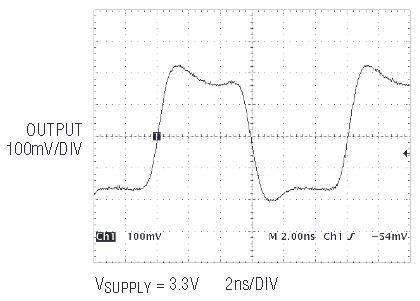Triple Amps Handle High-Res Workstation Video from Single Supplies
Introduction
Cutting edge, high resolution workstation displays demand cutting edge bandwidth and slew rate specs of their video amplifiers. Displays supporting 1920 × 1200 pixels, for example, must handle over 200Mpixels/s, less than five nanoseconds per pixel! System supply voltages have also been dropping in order to accommodate the new, faster digital processor technologies. Historically the fast amplifiers used for these formats required a total power supply of at least 6V, particularly in cable driver applications. Enter the LT6557 and LT6558, ultra-fast triple video amplifiers with internally fixed gains of two and unity, respectively. These devices have been specifically engineered to operate on single supply voltages down to 3.3V and yet maintain high bandwidth. Now it is practical to use a low voltage digital supply to directly power the analog video circuitry within high resolution products.
Features for Performance and Ease-of-Use
The LT6557 and LT6558 are bipolar voltage-feedback topology parts that are designed for exceptionally high slew-rate and large output swing capabilities for their operating voltage. A blazing slew rate of 2200V/μs is responsible for assuring that 400MHz of bandwidth is available, regardless of signal amplitude. These parts also include a single-resistor-programmable biasing feature that eliminates having to place resistor networks in the signal path to establish the correct DC operating point in single-supply operation. In the typical application for the LT6557 as a cable-driver or the LT6558 as an input buffer, as shown in Figure 1 and Figure 2, the only external components in the signal path are the coupling capacitors and termination resistors, simplifying layout and preventing frequency response anomalies.

Figure 1. An LT6557 single-supply RGB cable driver.

Figure 2. An LT6558 single-supply RGB buffer/ADC driver.
The output voltage of these amplifiers can swing to within 800mV of either rail, thus there is 1.7V of swing available on 3.3V, and 3.4V of swing on 5.0V. This means that there is plenty of swing available for RGB or HD video waveforms, plus allowance for offset variations due to AC-coupled picture content, for the unity gain LT6558 to operate on 3.3V or the LT6557 with gain of two to operate on 5V. Figure 3 shows the time response of the LT6558 to 700mVP-P pulses 6ns wide while operating from 3.3V (as in Figure 2). Note that for high fidelity waveform capture, a coupling circuit like that in Figure 1 is used, with a blocking capacitor and the signal measurement taken after a 75Ω double-termination. The same circuit operating at 5V exhibits even less overshoot. The typical current consumption is about 22mA per amplifier, and an enable feature is provided to permit a less than 1mA total current draw when the part is not in use. Both parts are available in a leaded SSOP-16 package or the leadless 5mm × 3mm DFN-16. The DFN model includes a bottom-side ground pad for enhanced thermal performance.

Figure 3. Fast pulse response of LT6558 on 3.3V single supply.
Automatic Biasing Feature
The LT6557 and LT6558 are designed specifically with single-supply AC-coupled operation in mind. Each input includes an internal current-controlled bias voltage source like that shown in Figure 3. A single external resistor RBCV programs the input bias voltages as shown in Figure 4 for the LT6557. The LT6558 RBCV function is similar to Figure 4, but is optimized for producing higher biasing levels to account for the lower gain and automatically tracks downward with the supply if below 4V. The selection of input bias point may depend on the application, but the values shown for the programming resistors in Figures 1 and 2 are representative of most designs.

Figure 4. Simplified schematic of LT6557 input biasing circuit (LT6558 similar).

Figure 5. Relationship of LT6557 input bias voltage to programming resistor RBCV.
Conclusion
The LT6557 and LT6558 triple video amplifiers are optimized specifically for operation on low voltage single supplies. With preset gain and programmable biasing, these devices offer minimal parts-count AC-coupled amplifier solutions for very high-resolution applications. The LT6557, with its gain of two, is designed for RGB output ports such as in video routers and KVM switch products. The LT6558, with unity gain, is designed as an RGB input port buffer and/or ADC driver, such as in computer or home-theater display products.




















